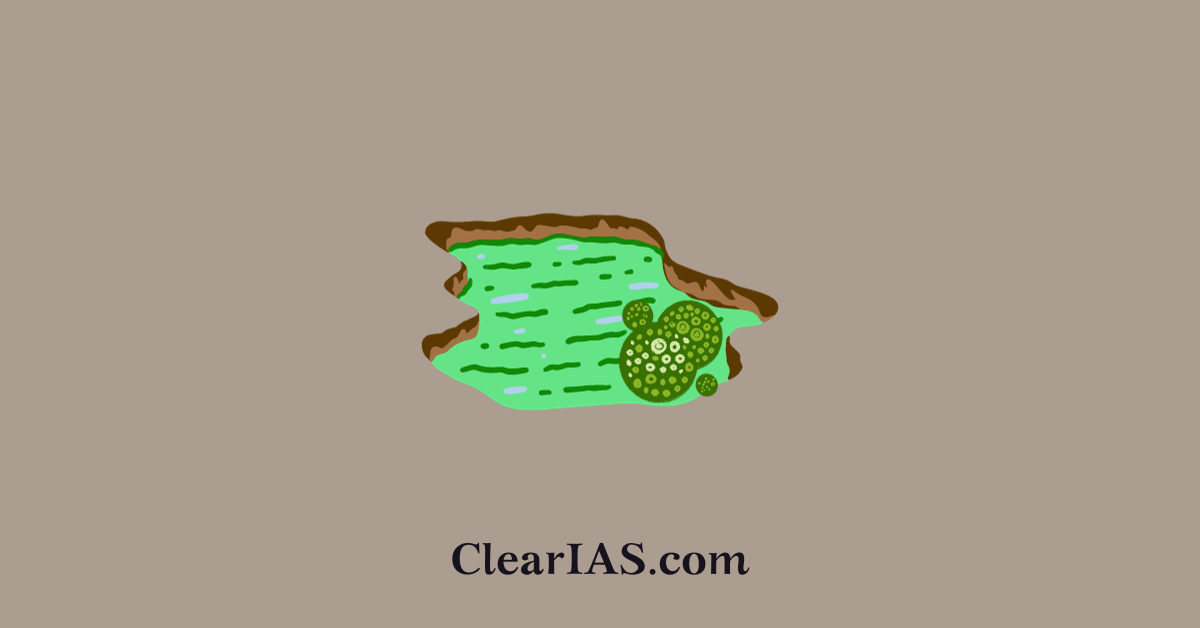
An algal bloom refers to a rapid and excessive increase in the population of algae (phytoplankton) in aquatic ecosystems. Harmful algal blooms, or HABs, occur when colonies of algae grow out of control. Read here to learn more.
Recently, a report was published about the sea turning red at Puducherry Beach, and the preliminary analysis suggests an algal bloom.
Ranging from microscopic, single-celled organisms to large seaweeds, algae are simple plants that form the base of food webs. Sometimes, however, their roles are more sinister.
Under the right conditions, algae may grow out of control and a few of these “blooms” produce toxins that can kill fish, mammals, and birds, and may cause human illness or even death in extreme cases.
Algal bloom
Harmful algal blooms in marine environments are often called “red tides“.
The sudden proliferation of algae can lead to visible discoloration of the water, often giving it a greenish hue, but blooms can also manifest in shades of red, brown, or other colors depending on the types of algae involved.
Algal blooms can occur in freshwater, marine, and brackish water environments. While not all blooms are harmful, certain types can have detrimental effects on the ecosystem, water quality, and even human health.
- Nutrient Enrichment: Algal blooms are often associated with an excess of nutrients, particularly nitrogen and phosphorus, in the water. These nutrients may come from agricultural runoff, sewage discharge, or other human activities.
- Warm Temperatures and Sunlight: Algal blooms tend to occur in warm conditions with abundant sunlight, as these factors promote the rapid growth of algae through photosynthesis.
- Toxic Algae Species: Some algal blooms are caused by toxic species of algae, known as harmful algal blooms (HABs). These toxins can have adverse effects on aquatic life, animals, and humans.
- Depletion of Oxygen: As algae die and decompose, they consume oxygen. In cases of extensive algal blooms, the decomposition process can deplete oxygen levels in the water, leading to hypoxic or anoxic conditions, which can harm fish and other organisms.
Types of Algae in Blooms
- Cyanobacteria (Blue-Green Algae): Certain species of cyanobacteria can form toxic algal blooms. The toxins produced by these algae, such as microcystins and saxitoxins, can be harmful to animals and humans.
- Dinoflagellates: Some dinoflagellates, a type of microscopic algae, can cause red tide events. These algae can produce toxins that can lead to fish kills and harm marine organisms.
- Diatoms: Diatoms are a group of algae that can contribute to non-toxic algal blooms. While they are generally not harmful, their rapid growth can still have ecological consequences.
- Golden algae: Although found mostly in oceans, golden algae (Prymnesium parvum) are an emerging problem in freshwater rivers, reservoirs, and lakes, particularly those with higher salinity (due to higher mineral content).
Causes of algal blooms
Algal blooms are caused by a combination of environmental factors that create favorable conditions for the rapid growth and proliferation of algae.
Nutrient pollution
- Nutrients like nitrogen and phosphorus, essential to plant growth, are a natural part of underwater ecosystems. But when they run off urban and rural surfaces and flow into a river, lake, pond, or reservoir in excess, a phenomenon known as nutrient pollution, they act like fertilizer and promote the growth of algae and bacteria.
Warm water
- Algae thrive in warm water conditions. Warmer temperatures enhance the metabolic rates of algae, allowing them to grow and reproduce more quickly.
- Algae are photosynthetic organisms that require sunlight for photosynthesis. Adequate sunlight promotes the photosynthetic activity of algae, leading to their rapid growth.
Stable Water Column
- In some water bodies, especially freshwater lakes, stratification can occur, creating distinct layers of water with different temperatures. The stable stratification prevents the mixing of surface and deeper waters, trapping nutrients in the upper layer where they fuel algal growth.
Stagnant Water
- Stagnant or slow-moving water allows algae to remain concentrated in one area, facilitating their growth. In contrast, swift currents may disperse algae, preventing the development of dense blooms.
Natural or Anthropogenic Eutrophication
- Eutrophication is the process by which a water body becomes enriched with nutrients, leading to increased algal growth. While natural eutrophication occurs over geological time scales, anthropogenic eutrophication is accelerated by human activities.
Other causes
- Agricultural Runoff: Runoff from agricultural lands can carry fertilizers, pesticides, and other pollutants into water bodies, contributing to nutrient enrichment.
- Urban Runoff: Urban areas with impervious surfaces can contribute to nutrient-rich stormwater runoff, enhancing nutrient levels in water bodies.
- Algae Trapping: Reservoirs created by dams can trap nutrients, leading to increased nutrient concentrations in the water. This can create conditions favorable for algal blooms.
- Altered Precipitation Patterns: Changes in precipitation patterns, a consequence of climate change, can influence nutrient runoff and water temperature, affecting the occurrence and intensity of algal blooms.
Read: Planetary boundaries; Nitrogen pollution
Impact of Algal Blooms
- Water Quality Degradation: Algal blooms can lead to the deterioration of water quality by reducing clarity and imparting undesirable colors and odors to the water.
- Fish Kills: Depletion of oxygen during the decomposition of algae can result in fish kills and harm other aquatic organisms.
- Toxicity to Animals: Harmful algal blooms can produce toxins that are harmful to aquatic animals, leading to illness or death.
- Human Health Risks: Some algal blooms produce toxins that pose health risks to humans through exposure via recreational activities, drinking water, or consumption of contaminated seafood.
- Economic Impact: Algal blooms can have economic implications, affecting fisheries, tourism, and recreational activities.
Prevention and Mitigation
- Nutrient Management: Implementing practices to reduce nutrient runoff from agriculture and urban areas can help prevent excessive nutrient enrichment in water bodies. These practices include planting cover crops, diversifying what’s grown, reducing tillage, properly applying compost and manure, and following fertilizer best practices.
- Monitoring and Early Detection: Regular monitoring of water bodies for algal biomass and toxin levels can facilitate early detection and management of potential algal blooms.
- Water Treatment: Certain water treatment technologies, such as the use of algaecides, can be employed to control algal blooms in specific situations. Protecting wetlands, which act as natural filters to improve water quality, capture runoff, and enhance biodiversity, is also vital.
- Restoration of Riparian Zones: Restoration of riparian zones and wetlands can help filter nutrients before they enter water bodies, reducing the risk of algal blooms.
Conclusion
Algal blooms are complex phenomena influenced by various environmental factors. Managing and mitigating their impacts often requires a holistic approach that addresses nutrient inputs, land-use practices, and the restoration of natural ecosystems.
Understanding the interactions among the factors is crucial for managing and preventing algal blooms. Implementing measures to control nutrient inputs, improve water quality, and promote sustainable land and water management practices can help mitigate the occurrence and impacts of algal blooms.
-Article by Swathi Satish








Leave a Reply